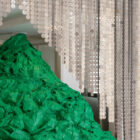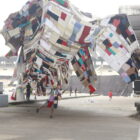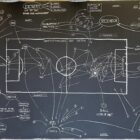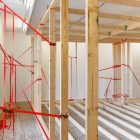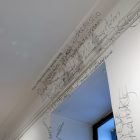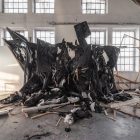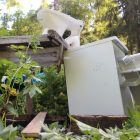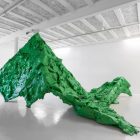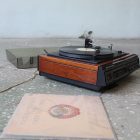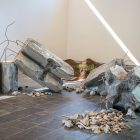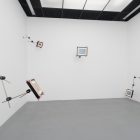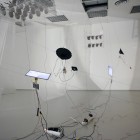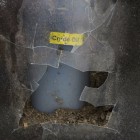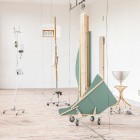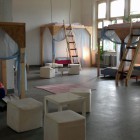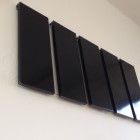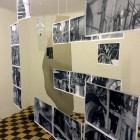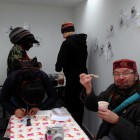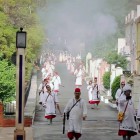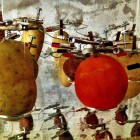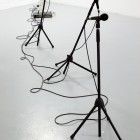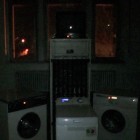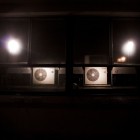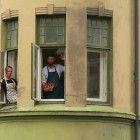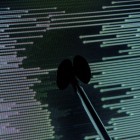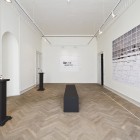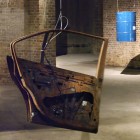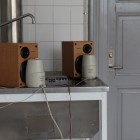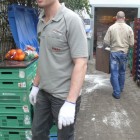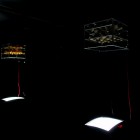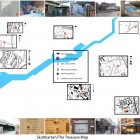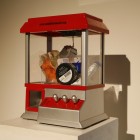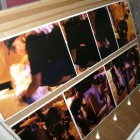Installation
Vibrant Mountains
re-(t)exHile
IN THE MIDST OF TWO WORLDS
Dysfunctional Deconstructions
Foto: Erik Sæter Jørgensen
Rogaland Kunstsenter, 2020
Building a universe
Turiec gallery, 2019
Foto:
LIVING IN THE BEGINNING OF TIMES 50.660940, 14.007270 / 12.19
Foto: Jirka Dvořák
Deconstructing an explicit content
Insubordination of bodies
Living in the beginning of times 59.923885, 10.758991 / 10.17
Sound Archeology
OUTSIDER
Living in the beginning of times
Ya-mae
afterlife
Afterlife, proof of life after death and other related critical concepts, such as the purpose of life and reincarnation of overproduction of food from supermarkets. The project offers the possibility to use expired food in energy production. As part of our process, we developed a pilot project where we observed that fruits and vegetables produce small amounts of electricity through an electrochemical reaction. This was achieved by inserting two different types of metal, copper and zinc, in each of the fruits in the installation. These fruits produce small amounts of electricity when they are connected in series and operate a small screen. From this moment our focus was aimed at finding ways of putting conservation of energy into practice; this is first law of thermodynamics, which states that energy can not be created or destroyed, only transferred from one form to another. Thus, our installation is also a way to visualize an analogue synthesis, where energy is transferred from fruit and vegetables to small plasma screen, creating a symbiosis. The installation is conceived as a social critique of the existing consumer society and a proposal for an alternative and further use of fruit and vegetables, which are regarded as superfluous and unsellable by supermarket chains.
Exhibited at Carl Berner Projektrom in december 2015.
photo: Yamile Calderon
Superfluous Identity IV
SUPERFLUOUS IDENTITY IV exhibited at Babel is part of a series of site-specific installations with the same title that examine the effects of the capitalist system and its impact on the individual. As a monstrous organism the installation unfolds throughout the rooms of Babel. Sound, objects and visual elements intertwine to encapsulate the viewer into this strange, superfluous identity with “pictographed” heartbeats via the cardiogram-like black tape stripes at the floor and the filtered soundscape. photo: Hanna Fauske, Andrea Lykken Kittilsen.superfluous identity III
The current dominant economic model has, particularly in the last decade, has proved to be a heavy-footed, exhausted juggernaut... former strength and stability, but also decay and disintegration of something that is trying to sustain in its last race.
curated by zuzana jakalova
photo: martin brazina
http://entrancegallery.com/
Bed & Breakfast
Bed & breakfast is another event of Kitchen Dialogues project, that took place in MeetFactory in collaboration with the 2015 Prague Quadrennial. Creating a social and cultural environment in our 100 square meter studio with modules/bedrooms built with recycled wood made it unique, warm and cosy, without forgetting all modern amenities. We offered accomodation to registred guests (max 12 per night) between 18th and 28th of june free of charge. During 9 days we have hosted a total of 59 guests that stayed between 1night and 1week of period each. We had the pleasure to accomodate guests from all around europe and oversees (israel, france, spain, lebanon, costa rica, czech republic, slovakia, sweden, norway, usa, germany, croatia, poland, uk, netherlands, slovenia, hungary, estonia, belgium, portugal, brazil etc).
more about the project on: http://kitchendialogues.com/
superfluous identity II
site-specific sound installation closely related to the Koh I Noor factory and its context over century of life. 5 black metal sheets, each of them with own transducer installed on the back side projecting the sound of 3 national anthems ( austrio-hungarian, checo-slovak and Czech) marking in this way the period of time of the factory.SUPERFLUOUS IDENTITY I
We take the Double Portrait of Hans Burgkmair with his wife Anna from Renaissance painter Lucas Furtenagela as the starting point for consideration of the work. The project is based on the theme memento mori that its impact in this work expanded from particular individuals, as seen on the image of the 16th century, the entire human community. The individual is closely linked with preset systems of the society in which he lives. Personification of the problem is hardly possible (although we report in prime time trying to prove otherwise). For an initial understanding of the problem, it must be seen in general. The work is a memento mori of the current economic model. As in our previous works, this will reflect the mood in society, politics and economics; a means of expression treated at a symbolic level. Immaterial nature of our work is related to liberating approach to creating work. It arises very often for the site and on site with recurrent sound.
The first part of the project was exhibited at Galerie Klubovna in Brno, Czech Republic in march 2015.
pictures by Marta Fišerová & Marcin Cwiklinski
Do It YourSelf
Kitchen dialogues come from the idea of lounging around the kitchen outside of the consumption system through the alternative of creating various social interactions. The project aims to change consumer sensory intellectual concept of overproduction of food from supermarkets. Apart of that, we also like to focus on another aspect of the project, which involves transport/ smuggling of waste though, Europe. Not only we personally hunt the food in the local dumpsters, but we also move the food from place to place to offer to different audience variety of products not possible to gather in the that place. The formula we seek in Kitchen dialogues is that people can taste "the problem of surplus".
The project has as a reference “Food” of Gordon Matta-Clark, Rirkrit Tiravanija relational works, Dieter Roth, “Eat Art” of Daniel Spoerri, “Food Cultura” by Antonio Miralda or Filippo Tommaso Marinetti and Fillia's “Manifesto of Futurist Cooking”.
The exhibition is part of a larger project that has taken part and form in many different way around Europe and Asia. shown at Trailer gallery in Umeå, Sweden in march 2015.
spanish (r)evolution
The video installation "spanish (r)evolution" shows how the roots of the participation of Spanish society to the disagreement of the established power system derives historically from the popular festivities in Spain; where libertarian and creative side emerged within them was the only legal form of public protest.
The aim of the piece is to generate an audible narrative that emulates the sound of a demonstration by thousands of citizens trough the sound from multiple simultaneous videos from various Spanish popular festivities.
The video was first shown as part of group exhibition Biopolitics of south side curated by Aristides Santana at Junefirst Gallery in Berlin, 2014 and later in form of installation as part of NEWROPE exhibition in Nitrianska Galeria curated Omar Mirza.
PDP/AV1
PDP/AV1 project has been focused on investigating the possibility of viewing organic battery power through plasma screens and synthesizers. The installation, shows the research process started 4 years ago to offer the possibility of using expired food in energy production and its a direct continuation of the previous stage AV1/AV2.
The project has been produced with generous support of Art Council Norway and Billedkunstnernes Vederlagsfond and exhibited in Atelier Nord ANX, Galleri Blunk and Høstutstillingen 2014.
Yes, I can (not)
The creation of the work "Yes, I can (not)" is generated by two unilateral perspectives on power politics in the global financial system. The first perspective deals on a personal level with the institutional relationship to the social talk, in a context that defines the identity of artists compared with the curator, the gallerist and academic institution. The second perspective examines the political dialogue issued for public comment in relation to the global monetary system as the crisis facing what are the consequences on the lives of workers.
The installation is presented as a space of dialogue between questionable dictation: microphones in the gallery are positioned in representative form of nesting of the power through the alteration of the functionality of the microphones on tripods. The microphones are used as speakers and spreading an audio recording of a voice pronouncing the verb of the power in affirmative and negative forms in all persons singular and plural, omitting only the first person singular. The tripods for sustaining the microphones are positioned 2 meters and 25 cm high respectively facing the viewer.
Sound installation; variable dimensions; microphones, tripods
Yes, I can (not), presented in two gallery spaces: KHM Gallery and Skånes konstförening in Malmö in september 2014.
Post-Market Economy, The sound of capitalism
Prague November 17, 1989, the new country's leaders began the process of democratization by introducing a market economy and return to Europe. Companies of Western European bloc and other American competing in the sale of new home accessories, their ultimate goal; selling appliances.
The sound installation works with the intensity of perception of sounds from various obsolete appliances incapable of being perceived by the human ear; through a systematic increase vibrational sound energy emitted by sources through incorporating multiple piezos.
Sound installation: 3 washers, 1 refrigerator, 2 TVs, 1 sound sistem, 1O piezos.
LEGIONELLOSIS
In the realization of Martinka Bobrikov and Oscar de Carmen for space INI appears the a specific context of space, defined by, among others, functionalist huge window behind him bizarrely placed ventilation system where the authors have used to accentuate the audio and visual aspects of the "genius loci" . These for them at the same time became the basis for metonymic linking with EEA air conditioning as frequent carriers of infection such as " Legionnaires' disease" . This association between hypertrophied air conditioning systems and diseases resulting from it often is only hidden meaning generator leading to infections that are transmitted to the audience by the authors. Its acoustic attack based on homogenized acoustic signal, is perhaps transformed into a springing the sound of toxic waste. This unlike the parable, the strange metonymy which the authors offer us here, certainly might result in a rather aesthetic impact. However, the " infectious " threat, in a harmless form of acoustic waves in this environment where we breathe through a closed system an already eighty years old conditioning, induces “weird” feelings...
The exhibition was part Je ne travaille jamais project curated by Viktor Čech at INI Prostor in March 2014, Prague.
In Process
A museum or arts centre collection is the backbone of the institution - apart from the planning and the programming. Within it is the museological plan which dictates the works´ procurement policies, aimed at building a culturally valuable and coherent collection. To which, in the case of public institutions, social responsibility is added, meaning, as well as its coherence and cultural value, that the collection should have a social value within its environment.
This approach leads us to study and question the arts centre/museum collection as a starting point to probe not only its statements, but also the intrahistoria of the institution, as well as its value to society as a whole.
Martinka Bobrikova and Oscar de Carmen are two artists who within their particular exhibition project present works belonging to the TEA Collection as an engine to challenge today´s museum concept, its functions and its operations. Testing, in turn, the different museographic models in the reception and exhibition of artistic works, as well as the production processes integrating external collaborators.
In Process doesn´t only feature the work and opinion of just those artists with works in the centre´s collection – as creators or political subjects – it also amplifies the visual and semantic potential of the exhibition, developing different collaborative networks between people, space and media.
It features contributions from a variety of cultural agencies that are participating with performances, including contemporary musicians, singers, cultural associations and performing arts technical experts.
The result of this pooling of multiple contributions is what constitutes the current exhibition, presenting a different institutional model, more concerned with the consolidation of local framework and creation of new cultural fabric. Perhaps a more sustainable operating model.
Foto: Teresa Arozena
Kitchen Dialogues
a series of environmental actions in the kitchen
This project aims to change consumer sensory intellectual concept of overproduction of food from supermarkets. In this occasion we will present food series of environmental actions in the kitchen around the theme of food surplus. We are interested in investigating the social changes among the common home environment meeting place called domestic kitchen and the meeting around the industrial kitchen in relation to the consumption of food surplus.
This private kitchen is a hybrid between being a guest in a dinner party and a restaurant. The shared experience of a set menu gives people common ground, and naturally the novelty factor is a conversation starter - it struck me as a comfortable cross between site specific theatre where you are not exactly sure what is going to happen, and a nice home party.
The private restaurant was located in Trondheim as a part of the exhibition CONSTANT. DEACY. organized by Rake visningrum. Private restaurant/ home setting was build by Heim og land arkitekter and took place in Elgesetergate 30b between 5th October and 31th October 2013. Elgesetergate 30b is an old abandoned apartment building which is now going to be demolished.
Kitchen Dialogues is an ongoing nomad project. go to the blog HERE
OLD FIRM
This installation aims to bring citizens closer to the no division in the social mass, with reference to the existing confrontation between Glasgow football teams of rangers and celtic football club, where there is great division between the groups in religion, politics and social economy .
The installation has the title of Old Firm that is the name that is given when the two teams meet in the Premiership (currently can not be because one is in first division and another in secondary).
The piece has 2 monitors, 2 speakers and an antenna at the extremity with 2 coins which together at the same time alternates the signal.
The piece was shown as part of the group exhibition ALWAYS ON THE MOVE in Fleming House Underground Car Park, Glasgow.
More info: www.glasmo.co.uk/
Urban Hunter
I am a gleaner, a poacher, or a treasure hunter … for others I feed on the city’s carrion.
I have determined the representation of my work in connection with the context in which it is shown, within the framework of the institutional territory of contemporary art. I act as though I were a collector for the meeting with the museum space; I adopt a fictitious objectivity mode in my supplanting of the subject. Helped by historical perspective, I build a collection based on copies of works of art on the theme of hunting, which acts through reappropriation of the terms of reference. In this way I produce an action that hides the information about my work and myself as the subject, and I acquire an inter-subjective quality, another connotative power, endowed with a false identity.
The masterpieces I have chosen are The Gleaners by Jean-François Millet, Basket of Fruit by Caravaggio, Treasure Island by Robert Louis Stevenson and Der Freischütz by Carl Maria von Weber.
Through audio guides I link descriptive narrations of my ventures as a “scavenger” to the copies of the works of art. The narration is produced parallely in two languages, Spanish and Slovak with english translation over it.
This project is sponsored by DATATON
RAINFOREST IV
“It occurred to me that one should reverse the application of loudspeakers so that they would not merely reproduce sound but actually produce sound. The idea is based on taking any number of fixed materials and transmitting sound through them; through their resonance frequencies they become a new instrument”, wrote Tudor.
This is newly interpreted work under the direction of Canadian composer, sound artist and Tudor specialist Matt Rogalsky, of American musician and composer David Tudor, which was created in 1973.
Found, converted or self-made objects are arranged freely around the room. Transducers on the objects cause the items to emit sounds. Resulting is an abundant, accessible “rainforest” of sounds.
partecipating artists: Martinka Bobrikova, Oscar de Carmen, Seth Davis, Cecilia Jonsson, Joonas Siren, Lauri Wuolio, Flopper (Christian Mastrup), Signe Lidén, Jonas Olsen and Thomas Wochnik
exhibited at Singuhr Hoergalerie
photo copyrights: singuhr / roman märz 2011
ECHOES 0.0
The presented installation is been made for a tiled room, a space that is normally considered inappropriate for any type of sound pieces. This is why I am interested in the re- appropriation of sounds considered "echoes” for how they are perceived, intelligible and identifiable. These sounds are sharp, hollow, and repetitive. By that I want to promote the resonance of the frequencies. What I want is to redistribute the resonance through the absorption, diffusion and isolation; in the way that spectator can get different experience depending from his position in the room.
you have to go right now!
In this work the intention is not to create an object to observe, but to involve the public in an action that may be remembered. This opens a new stage in our production, with more social character in our personal work.
The work's title refers to a conversation between the artists and the manager of a supermarket, after they collected of food products found in the waste container of his company. These are mechanisms that construct and define the way of looking and acting of these two artists in their most recent work, after facing the illegality, the intrusion into private space and the threat of being arrested by authorities.
This work represent 2 different stories ( one audio and one video) that belongs to the same physical place but different time.
AV1/AV2
The presented installation is based on our long lasting research of the possibilities of generating the energy from redundant fruit and vegetables. By means of a simple open hardware the energy acquired from fruit and vegetables is transformed through integrated circuits into audio-visual installations. Apart from an interesting audio-visual form the installations become the social criticism of the current consumerist society and also offer a certain alternative for a further use of fruit and vegetables which were considered as redundant and unsalable by superstore chains.
The Treasure Map
We would like to share with the viewer the spots where you can get free food. may be in the trash but it is not junk. They kill an animal to sell you a steak and for the rest they do not care to make it garbage, because the economic profit margin is already done.
Showen as a part of Trust +Mistake collectieve exhibition at Göteborgs Stadsmuseum in 2010.
Entrance of the Gladiators
You do not feel what you do not see; the clean illustrated reality without possibility to face the painful truth gives no possibility to shudder at food in the garbage that are not trash.
Out of sight, out of mind, was showen in the collective exhibition Clouds of witness in Röda Sten 2010. Clouds of Witness is an exhibition of the students at the master's program C:art:media, Valand school of Fine Arts, and the bachelor program at the School of Photography, Gothenburg University.
Talking Garbage
In the art installation Talking Garbage the spectator see in the exhibition space 5 dumpsters. Within containers we show our fieldwork conducted in Santa Cruz de Tenerife, verifying through technical index cards, photographs, videos and sound documentation, the existing problems with food products destined to human consumption, which are classified as perishable by the supermarkets.
The lighting in the room is obtained through a fluorescent tubes located in each of the containers. Fluorescent tubes are connected to a switch that is activated when the spectator lifts the lid of the container.
Exhibited in ATENEO, La Laguna, Tenerife, Spain 2007.
